
Abstract
This discussion will first define the boundaries of each class, explicitly exposing their roles. The skill repertoire of the two classes will then be compared and their usefulness will be tested according to three categories: PvE, PvP, and Raid Effectiveness. Finally, solutions will be proposed to solve this class imbalance.
I. Introduction
Rangers are usually associated with the wisdom of nature, yet can be as deadly as the most skilled assassins if need be. They are the jack of all trades, harnessing the power of nature to cloak themselves and blend with their environment, slow down and ensnare the enemy's hands and feet, sharpen their weapons to a deadly pierce and preserve life through the art of healing. Rangers tend to be extremely dexterous, making them able to wield a repertoire of weapons. While most skilled with the bow through which they shoot arrows with deadly precision, they tend to be well versed in other forms of combat such as melee (i.e spear wielding and knuckle blade combat) although they pale in comparison to their warrior counterpart.
This is the "utopian" class role. However in Celtic Heroes, things tend to be a tad bit different, yet the spirit of it does not change.Rogues are stealthy and dexterous characters, able to sneak up on foes and backstab them from hiding. They focus on dodging attacks rather than withstanding damage and tend to eliminate their foes in the least amount of moves possible. They are extremely skilled with daggers, often dual-wielding them and rely on their speed and rapid strikes rather than sheer damage output. As with rangers, they can use their stealth abilities to disappear from sight and restrict the enemy when he is least aware.
- A ranger sacrifices speed and burst damage with relatively slow bow auto damage, range, and more powerful, slower skills. His auto damage far exceeds that of a dagger wielding individual.
- A rogue sacrifices range and power for wicked fast auto damage through the use of quick daggers and burst damage skills.
II. Skills
N.B: Bandage Wounds, Recuperate and Meditate are excluded form the list. Also, dexterity based and strength based skills are coded by color. Non-stat affected skills are black. Lastly, support skills encapsulate support skills as well as non-direct damage skills.
1. Raw Comparison

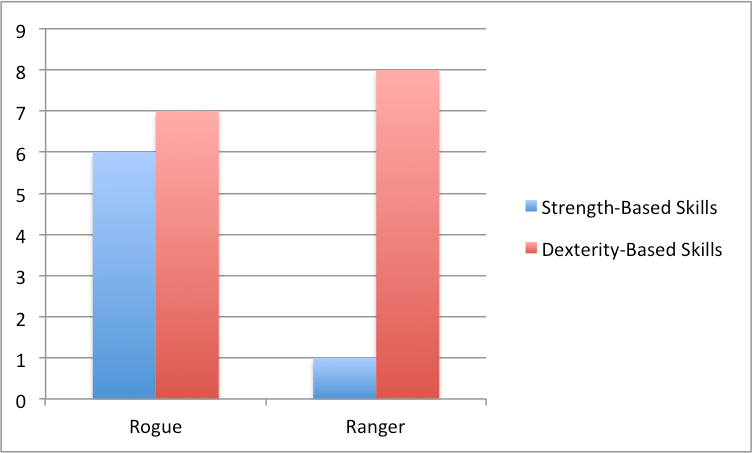
2. Usefulness Comparison
Let us now compare these skills according to their usefulness. A 0-5 scale will be used to quantify this (0 being utterly useless and 5 being perfect) and it will be applied at high-end status. This means that the degree of exactitude is only relevant to high-end rogues because at lower levels, things tend to be different.

- Riposte takes a 1 or a 5 because if you are leveling or farming, then it is a very very useful skill, dealing massive damage to multiple enemies on a strength build. However, at 190+, where a rogue's attention shifts from leveling to raiding, the skill is abandoned for other more strategic skills.
- Rapid Shot can be considered useless at high-end game status due to the extensive use of heroic elixirs of haste, however, on Killain or full not-so-important bosses, it can be a very useful cost-effective skill to have. Therefore it can range from 1 to 5.
- Double Shot, unlike double attack does not receive a 5 because it takes longer to cast, and wastes two autos which are the only thing rangers rely upon at end game.
- The rest is pretty self-explanatory and a consensus among the rogue/ranger community.
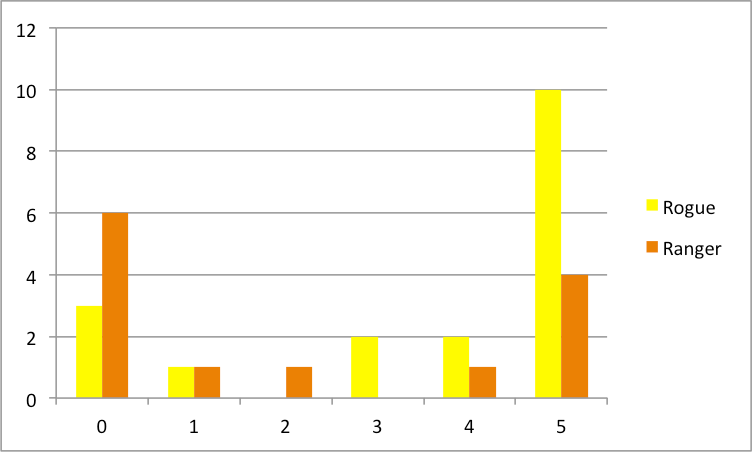
3. Comparison in the 3 Domains
Celtic Heroes gameplay currently revolves around three things: PvP (arena and castle), PvE (leveling, farming), and Raiding (killing raid bosses). Let's look at the usefulness of these skills applied in each category/gameplay style.
a. PvP
In PvP, a rogue and a ranger are pitted against each other, and the goal is to drop the enemy's health to 0 first. This means dishing out the most damage in the shortest amount of time, but also surviving damage, evading it in order to survive and kill the opponent.
Usually (great emphasis on usually):
- A PvP rogue will have a dexterity build because it provides great survivability through the evasion of autos, while still providing a ton of damage through the repertoire of skills available. Also, auto damage is not that greatly reduced because the offhand is usually an axe which provides a decent amount of elemental damage as well as strength points.
- A PvP ranger (saying the word makes me giggle, i've not heard of one
 ) who has no dexterity based skills will usually be a strength build, relying on his auto to quickly annihilate his opponent. He may use his skills such as light heal to heal himself, or bolas to slow down the enemy while attacking at a distance. However, in the current game mechanics, light heal is interrupted by the wicked fast rogue autos and the burst damage skills. Therefore 1. light heal is rendered useless and 2. bolas is rendered useless because shadow strike enables the rogue to spawn at the ranger and continue dishing damage. Not to mention that bolas' length time is reduced in PvP.
) who has no dexterity based skills will usually be a strength build, relying on his auto to quickly annihilate his opponent. He may use his skills such as light heal to heal himself, or bolas to slow down the enemy while attacking at a distance. However, in the current game mechanics, light heal is interrupted by the wicked fast rogue autos and the burst damage skills. Therefore 1. light heal is rendered useless and 2. bolas is rendered useless because shadow strike enables the rogue to spawn at the ranger and continue dishing damage. Not to mention that bolas' length time is reduced in PvP.
Let's look at each class turn by turn. We shall compare a level 190 rogue and ranger, with maxed abilities. Forgetting gear bonuses other than offhand, the rogue will have 155 strength, 555 dexterity, and 400 vitality. The ranger will have 555 strength, 400 vitality, and 150 dexterity.
Rogue
Skills Available:
- Damage Skills: Shadowstrike, Quick Strike, Riposte, Sneaky Attack, Life Steal
- Support Skills: Fast Reflexes, Poison Weapon.
Skills Available:
- Damage Skills: Double Shot
- Support Skills: Sharpen Weapons, Steady Aim.
N.B: Let's exclude fluctuation from auto damage. Also, keep in mind that sharpen weapons and steady aim add about 400-500 points to attack.

- Fast Reflexes, Sharpen Weapons, Steady Aim and Poison Weapon are cast before the fight therefore their damage-effectivness = damage dealt.
- Shadowstrike and Quick Strike are instantaneous and therefore their their damage-effectivness = damage dealt.

Taking this into account, here is the final result for damage-effectiveness:
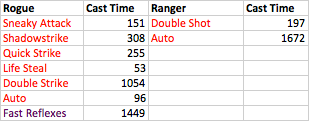
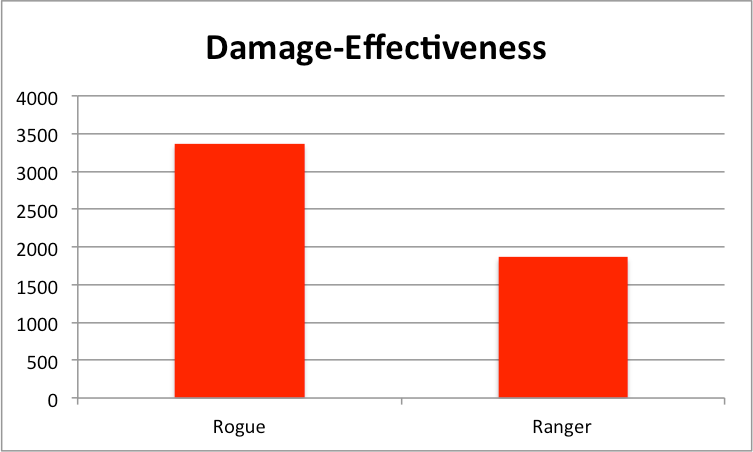
b. PvE
Too lazy to do this
c. Raid Bosses
On raid bosses, a ranger deals damage from a distance while a rogue is at melee distance from the boss and can get hit by AOE skills.
Usually (great emphasis on usually):
- A raid rogue will have a strength build because it provides decent, less avoided damage and can still deal a ton of damage through the repertoire of skills available. Auto damage is increased because of the strength build as well.
- A raid ranger who has no dexterity based skills will usually be a strength build, relying on his auto to quickly annihilate his opponent. He may use his skills such as light heal to heal himself, or bolas to slow down and kite the enemy while attacking at a distance. However, in the current game mechanics, bolas is highly evaded.
Let's look at each class turn by turn. We shall compare a level 190 rogue and ranger, with maxed abilities. Forgetting gear bonuses other than offhand, the rogue will have 710 strength, 5 dexterity, and 400 vitality. The ranger will have 555 strength, 400 vitality, and 150 dexterity.
Rogue
Skills Available:
- Damage Skills: Quick Strike, Sneaky Attack, Assassinate, Rend, Double Attack
- Support Skills: Poison Weapon, Expose Weakness, Smoke Bomb.
Skills Available:
- Damage Skills: Double Shot
- Support Skills: Sharpen Weapons, Steady Aim, Bolas, Light Heal.
N.B: I am not taking into account pierce resistance, and no haste elixirs are being used.
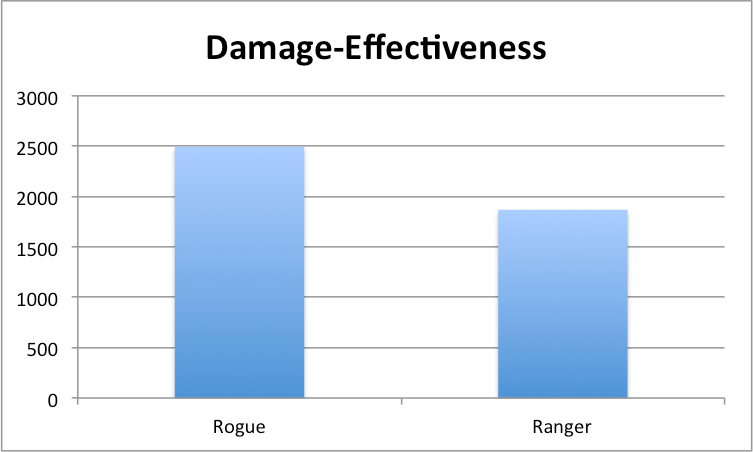
III. Solutions
- Make double shot instant cast, however it should have the downside of being able to miss.
- Make sharp shot strength based and/or give it poison damage
- Reduce barbed shot cast time, make it strength-based, and/or make it damage based.
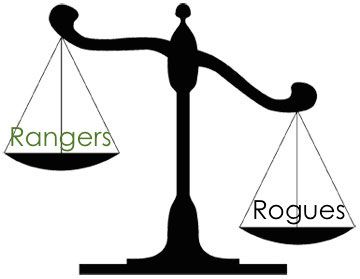
Please excuse any errors that could have been made, and thanks for taking the time to read.
V. References
- Swan's Auto Attack and Skill Formulas: http://celtic-heroes.com/forum/viewtopi ... =4&t=56130





